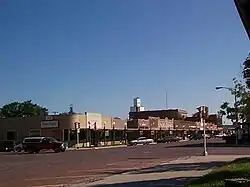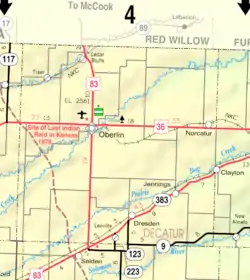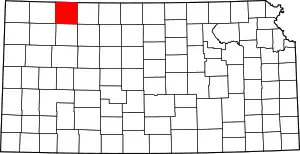Oberlin, Kansas
Oberlin is a city in and the county seat of Decatur County, Kansas, United States.[1] As of the 2020 census, its population was 1,644.[4]
Oberlin, Kansas | |
|---|---|
City and County seat | |
 Downtown Oberlin (1999) | |
 Location within Decatur County and Kansas | |
 KDOT map of Decatur County (legend) | |
| Coordinates: 39°49′23″N 100°31′51″W[1] | |
| Country | United States |
| State | Kansas |
| County | Decatur |
| Founded | 1872 |
| Platted | 1878 |
| Incorporated | 1885 [2] |
| Named for | Oberlin, Ohio |
| Government | |
| • Mayor | Ladd Wendelin |
| • Administrator | Haley Roberson |
| Area | |
| • Total | 1.91 sq mi (4.95 km2) |
| • Land | 1.91 sq mi (4.95 km2) |
| • Water | 0.00 sq mi (0.00 km2) |
| Elevation | 2,569 ft (783 m) |
| Population | |
| • Total | 1,644 |
| • Density | 860/sq mi (330/km2) |
| Time zone | UTC-6 (CST) |
| • Summer (DST) | UTC-5 (CDT) |
| ZIP code | 67749 |
| Area code | 785 |
| FIPS code | 20-52000 |
| GNIS ID | 485632[1] |
| Website | oberlin-kansas.com |
History
Oberlin was platted in 1878.[5] It was named after Oberlin, Ohio.[6] Its first post office was established in April, 1878,[7] and the city was incorporated in 1885.[8]
On September 30, 1878, Northern Cheyenne, fleeing from Indian Territory to their homes in the north during the Northern Cheyenne Exodus, attacked homesteaders near Oberlin, then a tiny hamlet. The raid's victims are commemorated in the "Last Indian Raid in Kansas" room of the Decatur County Museum, and by a monument in the town cemetery.[9][10]
Geography
Oberlin lies on the northwest side of Sappa Creek, a tributary of the Republican River, in the High Plains region of the Great Plains.[11] Located at the intersection of U.S. Route 36 and U.S. Route 83 in northwest Kansas, it is 228 miles (367 km) northwest of Wichita, 238 miles (383 km) east of Denver, and 320 miles (510 km) west-northwest of Kansas City.[11][12]
According to the United States Census Bureau, it has a total area of 1.91 square miles (4.95 km2), all land.[13]
Climate
Oberlin has a humid continental climate (Köppen Dfa), with hot, dry summers and cold, dry winters. The average temperature is 52 °F (11 °C) with temperatures exceeding 90 °F (32 °C) an average of 62 days a year and dropping below 32 °F (0 °C) an average of 158 days a year. It typically experiences precipitation 66 days a year and snowfall 11 days a year. Precipitation averages 23 inches (574 mm) per year, and snowfall averages 32 inches (80 cm) per year.[14] On average, January is the coldest month, and July is both the hottest month and the wettest month. The hottest temperature recorded there was 111 °F (44 °C) in 1954; the coldest temperature recorded was -31 °F (-35 °C) in 1989.[15]
| Climate data for Oberlin, Kansas | |||||||||||||
|---|---|---|---|---|---|---|---|---|---|---|---|---|---|
| Month | Jan | Feb | Mar | Apr | May | Jun | Jul | Aug | Sep | Oct | Nov | Dec | Year |
| Record high °F (°C) | 78 (26) |
85 (29) |
93 (34) |
97 (36) |
103 (39) |
110 (43) |
111 (44) |
109 (43) |
107 (42) |
99 (37) |
88 (31) |
83 (28) |
111 (44) |
| Average high °F (°C) | 40 (4) |
46 (8) |
55 (13) |
65 (18) |
74 (23) |
86 (30) |
92 (33) |
89 (32) |
81 (27) |
69 (21) |
51 (11) |
43 (6) |
66 (19) |
| Daily mean °F (°C) | 28 (−2) |
33 (1) |
41 (5) |
51 (11) |
61 (16) |
72 (22) |
77 (25) |
75 (24) |
66 (19) |
54 (12) |
38 (3) |
30 (−1) |
52 (11) |
| Average low °F (°C) | 13 (−11) |
17 (−8) |
25 (−4) |
35 (2) |
47 (8) |
57 (14) |
63 (17) |
60 (16) |
50 (10) |
36 (2) |
24 (−4) |
16 (−9) |
37 (3) |
| Record low °F (°C) | −28 (−33) |
−19 (−28) |
−25 (−32) |
10 (−12) |
22 (−6) |
34 (1) |
41 (5) |
40 (4) |
22 (−6) |
9 (−13) |
−19 (−28) |
−31 (−35) |
−31 (−35) |
| Average precipitation inches (mm) | 0.49 (12) |
0.63 (16) |
1.65 (42) |
2.20 (56) |
3.65 (93) |
3.30 (84) |
3.75 (95) |
2.74 (70) |
1.50 (38) |
1.17 (30) |
1.03 (26) |
0.48 (12) |
22.59 (574) |
| Average snowfall inches (cm) | 6.5 (17) |
4.8 (12) |
6.7 (17) |
2.4 (6.1) |
0 (0) |
0 (0) |
0 (0) |
0 (0) |
0.3 (0.76) |
1.1 (2.8) |
4.5 (11) |
5.2 (13) |
31.6 (80) |
| Average precipitation days (≥ 0.01 in) | 2.7 | 3.1 | 5.5 | 6.1 | 9.3 | 7.7 | 8.0 | 7.3 | 5.3 | 4.5 | 3.8 | 2.8 | 66.2 |
| Average snowy days (≥ 0.1 in) | 2.5 | 1.8 | 2.3 | 0.8 | 0 | 0 | 0 | 0 | 0.1 | 0.2 | 1.4 | 2.1 | 11.2 |
| Source: National Weather Service;[14] The Weather Channel[15] | |||||||||||||
Demographics
| Census | Pop. | Note | %± |
|---|---|---|---|
| 1890 | 976 | — | |
| 1900 | 937 | −4.0% | |
| 1910 | 1,157 | 23.5% | |
| 1920 | 1,247 | 7.8% | |
| 1930 | 1,629 | 30.6% | |
| 1940 | 1,878 | 15.3% | |
| 1950 | 2,019 | 7.5% | |
| 1960 | 2,337 | 15.8% | |
| 1970 | 2,291 | −2.0% | |
| 1980 | 2,387 | 4.2% | |
| 1990 | 2,197 | −8.0% | |
| 2000 | 1,994 | −9.2% | |
| 2010 | 1,788 | −10.3% | |
| 2020 | 1,644 | −8.1% | |
| U.S. Decennial Census | |||
2010 census
As of the census[16] of 2010, there were 1,788 people, 824 households, and 477 families residing in the city. The population density was 936.1 inhabitants per square mile (361.4/km2). There were 1,046 housing units at an average density of 547.6 per square mile (211.4/km2). The racial makeup of the city was 96.9% White, 0.7% African American, 0.7% Native American, 0.3% Asian, 0.4% from other races, and 1.0% from two or more races. Hispanic or Latino of any race were 1.0% of the population.
There were 824 households, of which 21.2% had children under the age of 18 living with them, 47.8% were married couples living together, 7.3% had a female householder with no husband present, 2.8% had a male householder with no wife present, and 42.1% were non-families. 39.6% of all households were made up of individuals, and 19.6% had someone living alone who was 65 years of age or older. The average household size was 2.07 and the average family size was 2.73.
The median age in the city was 52 years. 20% of residents were under the age of 18; 4.1% were between the ages of 18 and 24; 17.4% were from 25 to 44; 29% were from 45 to 64; and 29.5% were 65 years of age or older. The gender makeup of the city was 47.4% male and 52.6% female.
2000 census
As of the census[17] of 2000, there were 1,994 people, 879 households, and 550 families residing in the city. The population density was 1,039.7 inhabitants per square mile (401.4/km2). There were 1,048 housing units at an average density of 546.5 per square mile (211.0/km2). The racial makeup of the city was 97.79% White, 0.25% African American, 0.15% Native American, 0.20% Asian, 0.05% Pacific Islander, 0.25% from other races, and 1.30% from two or more races. Hispanic or Latino of any race were 1.15% of the population.
There were 879 households, out of which 25.8% had children under the age of 18 living with them, 51.8% were married couples living together, 7.6% had a female householder with no husband present, and 37.4% were non-families. 36.2% of all households were made up of individuals, and 20.7% had someone living alone who was 65 years of age or older. The average household size was 2.15 and the average family size was 2.78.
In the city, the population was spread out, with 22.6% under the age of 18, 5.1% from 18 to 24, 21.0% from 25 to 44, 21.4% from 45 to 64, and 29.9% who were 65 years of age or older. The median age was 46 years. For every 100 females, there were 85.1 males. For every 100 females age 18 and over, there were 79.3 males.
The median income for a household in the city was $30,816, and the median income for a family was $34,583. Males had a median income of $27,177 versus $16,488 for females. The per capita income for the city was $17,271. About 5.0% of families and 6.8% of the population were below the poverty line, including 7.1% of those under age 18 and 4.4% of those age 65 or over.
Arts and culture
Oberlin is home to the Last Indian Raid Museum, which contains multiple late 19th and early 20th century buildings filled with artifacts chronicling the history of the area and early Plains settlers. Examples include a 1930s grocery store and a one-room schoolhouse built in 1922.[18]
Its a recreation center, completed in 2010, includes a 3D-capable movie theater and a bowling alley.[19]
The Oberlin Area Band is an intergenerational band that rehearses weekly and performs quarterly.
Parks and recreation
The Oberlin City Park, near Decatur Community High School, and has a playground, picnic shelter, band shell, and full basketball court, and is home to the Oberlin swimming pool.
Sappa Park
The City of Oberlin is the owner of the Sappa Park two miles east of town. Formerly a state park, it has wetlands, bike and hiking paths, a nine-hole disc golf course, and a shelter house built by the Works Progress Administration in the 1930s. It is currently undergoing a multi-year improvement project. A nine-hole golf course is adjacent to it.[20]
The park, originally by a lake, was developed in 1935 by the National Park Service. The Works Progress Administration (WPA) hired unemployed young men to build its dam and shelter house. It was dedicated in 1939, but over the years silt filled the lake and it was drained. Part of the lake has recently been restored as a wetlands.[21]
Government
Oberlin is a city of the third class, according to state statute, with a mayor-council form of government.[22] The city council consists of five members and meets on the first and third Thursday of each month at 7PM.[23][24]
Education
The community is served by Oberlin USD 294 public school district, which operates two schools in the city: Oberlin Elementary School (Grades Pre-K-6) and Decatur Community Junior/Senior High School (7-12).[25][26]
Media
The Oberlin Herald is the city's sole newspaper, published weekly.[27]
Two FM radio stations are licensed to and broadcast from Oberlin:[28]
- K-LOVE (translator station K217CY), at 91.3 FM, playing a Christian Contemporary format
Oberlin is in the Wichita-Hutchinson, Kansas television market.[29] NBC affiliate KSNK, licensed to McCook, Nebraska, broadcasts on channel 8 from studios west of Oberlin.[30] It is a satellite station of KSNW in Wichita.[31]
Notable people
Notable people who were born in and/or have lived in Oberlin include:
- Brun Campbell – ragtime composer, pianist[32]
- Sam Francis – #1 pick in 1937 NFL Draft, football coach at Kansas State University
- Elmer Hackney – NFL running back[33]
- Richard Rogers – U.S. federal judge[34]
- Cora Simpson – nurse and nurse educator, founder of nursing school in Fuzhou, China
References
- U.S. Geological Survey Geographic Names Information System: Oberlin, Kansas
- Oberlin - History
- "2019 U.S. Gazetteer Files". United States Census Bureau. Retrieved July 24, 2020.
- "Profile of Oberlin, Kansas in 2020". United States Census Bureau. Archived from the original on March 15, 2022. Retrieved March 15, 2022.
- Columbia-Lippincott Gazetteer, 1952 Edition, p. 1361
- Kansas State Historical Society (1916). Biennial Report of the Board of Directors of the Kansas State Historical Society. Kansas State Printing Plant. pp. 174.
- "Kansas Post Offices, 1828-1961 (archived)". Kansas Historical Society. Archived from the original on October 9, 2013. Retrieved June 8, 2014.
- Blackmar, Frank Wilson (1912). Kansas: A Cyclopedia of State History, Volume 2. Standard Publishing Company. pp. 380.
- "Last Indian Raid Museum"
- Alan Boye (September 1, 2001). Holding Stone Hands: On the Trail of the Cheyenne Exodus. Bison Books. pp. 177–191. ISBN 0-8032-6185-3. ISBN 978-0803261853
- "2003-2004 Official Transportation Map" (PDF). Kansas Department of Transportation. 2003. Retrieved May 24, 2011.
- "City Distance Tool". Geobytes. Archived from the original on October 5, 2010. Retrieved May 24, 2011.
- "US Gazetteer files 2010". United States Census Bureau. Archived from the original on January 12, 2012. Retrieved July 6, 2012.
- "NOWData - NOAA Online Weather Data". National Weather Service Forecast Office - Goodland, KS. Retrieved May 27, 2011.
- "Average weather for Oberlin, KS". The Weather Channel. Retrieved May 27, 2011.
- "U.S. Census website". United States Census Bureau. Retrieved July 6, 2012.
- "U.S. Census website". United States Census Bureau. Retrieved January 31, 2008.
- "Virtual Tour". Last Indian Raid Museum. Last Indian Raid Museum. Retrieved July 29, 2011.
- "Recreational Activities". Oberlin, Kansas Official Web Site. Oberlin-Decatur Economic Development Board. Retrieved July 29, 2011.
- "Sappa Park". Oberlin Explorations. The Kansas Sampler Foundation. Retrieved July 29, 2011.
- Davis, Kimberley (July 27, 2011). "National agency developed park east of Oberlin". The Oberlin Herald. Oberlin, Kansas.
- "Oberlin". Directory of Kansas Public Officials. The League of Kansas Municipalities. Retrieved May 27, 2011.
- Oberlin - Government
- Oberlin - City Council Agenda
- "USD 294". Oberlin USD 294. Retrieved May 27, 2011.
- "Oberlin, Kansas". City-Data. Retrieved May 27, 2011.
- "Oberlin Herald". Mondo Times. Retrieved May 27, 2011.
- Frequency and callsign information from "FMQ FM Radio Database Query". Federal Communications Commission. Archived from the original on August 25, 2009. Retrieved September 7, 2009.
- "TV Market Maps". EchoStar Knowledge Base. Archived from the original on August 20, 2008. Retrieved May 27, 2011.
- "Station Search". BIA Kelsey. Archived from the original on August 28, 2012. Retrieved May 27, 2011.
- "Stations for Goodland, Kansas". RabbitEars.Info. Retrieved May 27, 2011.
- "Brun Campbell". AllMusic. Retrieved May 27, 2011.
- "Elmer Hackney". National Football League. Retrieved May 27, 2011.
- "Rogers, Richard Dean". Biographical Directory of Federal Judges. Federal Judicial Center. Retrieved May 27, 2011.
